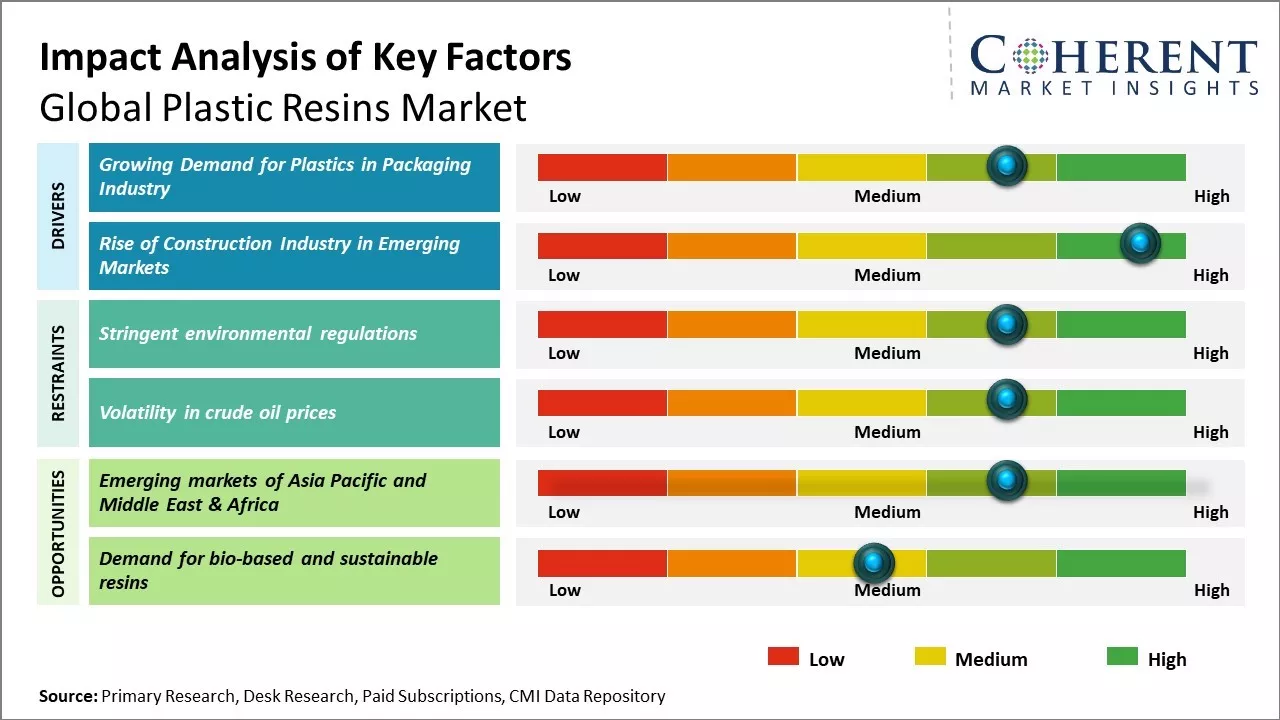Plastic Resins Market Size and Trends
The plastic resins market is estimated to be valued at USD 872.43 Bn in 2025 and is expected to reach USD 1,196.03 Bn by 2032, exhibiting a compound annual growth rate (CAGR) of 4.6% from 2025 to 2032.

Discover market dynamics shaping the industry: Download Free Sample
The demand for plastic resins is expected to grow steadily during the forecast period. The market is driven by increasing application of plastics in various end-use industries like packaging, consumer goods, construction, and automotive. Wide acceptance of plastic as a sustainable and affordable material compared to traditional materials also supports the demand. However, strict environmental regulations around plastic waste disposal and recycling may moderately impact the market growth.
Growing Demand for Plastics in Packaging Industry
The packaging industry has seen immense growth in the last few decades. There is increasing preference of plastic packaging over conventional packaging methods like glass and metal. Plastic offers advantages like durability, resistance to damage, light weight, and flexibility in shapes and sizes. It allows innovative packaging designs that effectively protect and extend the shelf life of products. Food and beverages was one of the earliest adopters of plastic packaging where plastic bottles, containers, and wraps are extensively used to store products. Another prominent segment is consumer goods where plastic plays a pivotal role in packaging personal and homecare products. Growing e-commerce sector has also fueled demand as plastic serves as an ideal material for protective wrappings and mailers. Most retailers prefer plastic carriers and folders that can withstand handling and transportation. Manufacturers recognize the value of effective packaging for brand building and promoting their products on shelves as well as online marketplaces. Plastic offers an affordable solution to package a variety of goods aimed at large consumer base. With consumers increasingly opting for packaged and processed food due to busy lifestyles, packaging consumption is expected to swell dramatically. This augurs well for plastic resin manufacturers.
Market Concentration and Competitive Landscape

Get actionable strategies to beat competition: Download Free Sample
Rise of Construction Industry in Emerging Markets
In recent years, the construction industry has picked up momentum in developing economies of Asia Pacific, Africa, and Latin America driven by robust economic growth and massive infrastructure development plans. Governments are investing heavily in building roads, bridges, airports, and urban infrastructure to enhance connectivity and accelerate industrialization. Rapid urbanization with expanding cities necessitates new residential and commercial properties. There is a universal shift towards modern construction techniques utilizing steel and concrete structure over traditional materials. Plastic resins like PVC finds multifarious applications in building interiors as well as exteriors. It is used to produce pipes, fittings, window profiles, doors, and roofing sheets that add strength, flexibility and durability to structures. PVC flooring enjoys higher demand than ceramic or wood floors especially in high traffic commercial establishments due to easy maintenance. Fiber reinforced plastics are gaining traction as lightweight substitutes for steel in fabrication of doors, windows and railings. Insulation made from polystyrene and polyethylene resins provide effective thermal and sound insulation in walls and attics. Growth in housing and real estate market drives demand for ancillary plastic products integral to construction. Rising incomes and improving standards of living in developing countries will ensure steady growth prospects for the plastic resins.
Key Takeaways from Analyst:
North America and Asia Pacific are likely to dominate the market share due to high plastic consumption in various end-use industries such as packaging, construction, automotive, and consumer goods. The construction industry will drive significant demand for resins as plastic pipes and fittings see widespread adoption in infrastructure projects. Strict regulations regarding use of specific resins may restrain market potential to some extent.
Opportunities lie in developing lightweight and high-strength resins for automotive applications. Polypropylene and polyethylene continue gaining traction as suitable replacements for metals. Environmental concerns pose a challenge but also pave the way for bioplastics to make inroads. Adoption in electric vehicles gives a push to engineering-grade resins. Client needs around sustainable and recyclable packaging create scope for innovation in resin formulation and manufacturing technologies. Applications in specialty membranes and nonwoven materials open new avenues.
The market is fairly fragmented and cost-sensitive. Regional and specialized players aim to fortify positions with value-added product differentiation. Resin consumption patterns vary significantly across developed versus developing economies. Overall, steady gains in related end-markets ensure largely stable resin demand conditions remain intact. Close monitoring of shifts in regulatory stands and evolving environmental norms will be crucial for strategic decision making.
Market Challenges: Stringent environmental regulations
Stringent environmental regulations across major economies are posing challenges for the growth of the global plastic resins market. Governments are increasingly banning certain single-use plastic items and imposing restrictions on plastic packaging to reduce plastic waste. This is impacting the demand for plastic resins that are used to manufacture such products.
Market Opportunities: Emerging markets of Asia Pacific and Middle East & Africa
The emerging markets in Asia Pacific and Middle East & Africa present significant opportunities for growth in the global plastic resins market. The Asia Pacific region, home to over 4 billion people, is witnessing rapid urbanization and industrialization which is driving increased demand for plastics from various end use industries such as packaging, construction, automotive etc. Countries like China, India, Indonesia and Vietnam are major manufacturing hubs and have huge plastic consumption.

Discover high revenue pocket segments and roadmap to it: Download Free Sample
Insights by Type: Properties Drive Demand for Crystalline Resins
In terms of type, crystalline resin is expected to contribute 56.3% share of the plastic resins market in 2025 owing to its unique physical and mechanical properties. Crystalline resins, such as polyethylene, polypropylene, polyvinyl chloride, and polystyrene, have a crystalline molecular structure that gives them strength, rigidity and resistance to chemicals and moisture. This crystalline structure allows the material to withstand stresses and maintain its shape even after years of use.
The crystalline structure also gives these resins excellent corrosion resistance. They can withstand exposure to acids, alkalis, salts, and other corrosive substances that would quickly degrade other plastic materials. This corrosion resistance has made crystalline resins the preferred choice for applications involving exposure to chemicals or outdoor weathering. They are commonly used to manufacture chemical storage tanks, pipes, linings, and coatings.
In addition, crystalline resins have high melting points compared to other thermoplastics. This heat resistance allows products made from these resins to withstand higher temperatures without deforming or melting. The high melting points also give parts improved dimensional stability at elevated temperatures. As a result, crystalline resins are often used for automotive, appliance and electronics components that may be exposed to heat. Crystalline resins also have good electrical insulation properties, making them suitable for uses involving the transmission of electricity. Common applications include wire and cable coatings, switch housings and electrical connectors. Their mechanical strength also makes them useful for demanding structural applications like construction materials and industrial equipment where durability is required. The unique balance of properties that crystalline resins offer, including strength, rigidity, durability and heat and chemical resistance has resulted in their wide use across industries. This drives their high market share in the overall plastic resins market.
Insights by Application: Packaging Drives Demand in the Application Segment
In terms of application, the packaging segment is expected to contribute 42.7% share of the plastic resins market in 2025. Plastic resins offer properties that make them uniquely suitable for packaging applications compared to other materials. Plastic resins can be easily molded, formed or extruded into an almost endless variety of packaging shapes and sizes at high production speeds. They allow manufacturers to customize packaging designs to their specific product and change designs quickly and cost effectively as needs evolve. The versatility of plastics in packaging machinery has helped drive their adoption.
In addition, plastic resins provide an excellent barrier against moisture, oxygen, light, and microbial contaminants compared to other packaging materials. This allows products to maintain freshness and quality longer. The barrier properties of plastics have replaced traditional materials for numerous applications and extended product shelf life. Plastic resins also have corrosion resistance that makes packages durable and capable of withstanding distribution processes involving chemicals or other corrosive substances. For example, plastic bottles and containers can hold acidic or alkaline liquids without degrading.
Lightweight plastic packages made from resins consume less material and space during transport compared to other packaging materials like glass or metal. They reduce distribution costs for manufacturers. Plastic pack bags, wraps, and films are also inexpensive to produce, dispose of and replace when damaged compared to alternatives. These combined advantages around functionality, cost effectiveness and performance have made plastic resins the dominant choice for modern packaging needs. This drives the high share of the packaging segment within the overall plastic resins market.
Regional Insights

Need a Different Region or Segment? Download Free Sample
North America has established itself as the dominant player in the global plastic resins market over the years. The region is expected to account for 36.0% share in 2025. The region is home to leading plastic resin manufacturers who have maintained a strong foothold in this space through continuous investment in cutting-edge production technologies. Several factors such as a large consumer base, strong demand from end-use industries, and presence of regulatory standards have propelled North America to the top spot. In particular, the U.S. drives much of the regional market growth due to a thriving industrial sector and established infrastructure to support plastic usages. The availability of raw materials and proximity to customers have allowed manufacturers to capture a major share of the market through competitive pricing and efficient supply chains.
The Asia Pacific region has emerged as the fastest growing market for plastic resins globally. Rapid industrialization and urbanization trends across developing nations like China and India are fueling the adoption of plastics in various applications. A burgeoning middle class with rising disposable incomes presents an enormous market opportunity for plastic resin producers. Additionally, Asia Pacific is a key exporter of resins to other international markets given its low production costs and growing manufacturing prowess. Countries in Southeast Asia such as Indonesia, Malaysia, and Thailand are also experiencing higher plastic resin demand from industries like packaging, electronics, and automotive. As living standards improve in the region, plastic resin consumption is projected to climb further over the coming years. The Asia Pacific market benefits from strong government support for manufacturing sectors and special economic zones to attract global investments. This has enabled the region to quickly become an important player with significant growth potential in the global plastic resins market.
Market Report Scope
Plastic Resins Market Report Coverage
| Report Coverage | Details | ||
|---|---|---|---|
| Base Year: | 2024 | Market Size in 2025: | USD 872.43 Bn |
| Historical Data for: | 2020 To 2024 | Forecast Period: | 2025 To 2032 |
| Forecast Period 2025 to 2032 CAGR: | 4.6% | 2032 Value Projection: | USD 1,196.03 Bn |
| Geographies covered: |
|
||
| Segments covered: |
|
||
| Companies covered: |
Dow, DuPont, BASF SE, SABIC, Sumitomo Chemical Co., Ltd., Evonik Industries AG, Celanese Corporation, Eastman Chemical Company, Chevron Phillips Chemical Co., LLC, LOTTE Chemical Corporation, Exxon Mobil Corporation, Formosa Plastics Corporation, TORAY INDUSTRIES, INC., MITSUI & CO. LTD, TEIJIN LIMITED, LG Chem, and Avient Corporation |
||
| Growth Drivers: |
|
||
| Restraints & Challenges: |
|
||
Uncover macros and micros vetted on 75+ parameters: Get instant access to report
Plastic Resins Industry News
- On June 18, 2024, Dow launched new Revoloop recycled plastic resins
- In December 2023, LyondellBasell introduced a new recycled resin derived from discarded maritime plastics
- In 2023, Montachem and Loliware launched seaweed-based resins into the European market
- In January 2023, SABIC introduced a new ULTEM resin grade that it claims will aid designers in the styling and aesthetics of consumer electronics components
*Definition: The plastic resins market refers to the industry and trade related to the manufacturing and sale of raw plastic resins that are used in various plastic manufacturing processes. The major plastic resins included in this market are polyethylene terephthalate, polyvinyl chloride, polyethylene, polypropylene, polystyrene, and engineering plastics. These raw plastic materials are purchased by plastic product manufacturers, plastic bottle producers, pipe makers, and other plastic processing companies that mold or shape the resins into a wide variety of end-use plastic products.
Market Segmentation
Type Insights (Revenue, USD Bn, 2020 - 2032)
-
- Crystalline Resin
- Epoxy
- Polyethylene
- Others
- Non-crystalline Resin
- Polyvinyl Chloride (PVC)
- Polystyrene (PS)
- Others
- Engineering Plastic
- Nylon
- Polybutylene Terephthalate (PBT)
- Others
- Others
- Engineering Plastic
- Nylon
- Polybutylene Terephthalate (PBT)
- Others
- Others
- Crystalline Resin
- Application Insights (Revenue, USD Bn, 2020 - 2032)
- Packaging
- Automotive
- Construction
- Electrical & Electronics
- Others
- Regional Insights (Revenue, USD Bn, 2020 - 2032)
- North America
- U.S.
- Canada
- Latin America
- Brazil
- Argentina
- Mexico
- Rest of Latin America
- Europe
- Germany
- U.K.
- Spain
- France
- Italy
- Russia
- Rest of Europe
- Asia Pacific
- China
- India
- Japan
- Australia
- South Korea
- ASEAN
- Rest of Asia Pacific
- Middle East & Africa
- GCC Countries
- Israel
- Rest of Middle East & Africa
- North America
- Key Players Insights
- Dow
- DuPont
- BASF SE
- SABIC
- Sumitomo Chemical Co., Ltd.
- Evonik Industries AG
- Celanese Corporation
- Eastman Chemical Company
- Chevron Phillips Chemical Co., LLC
- LOTTE Chemical Corporation
- Exxon Mobil Corporation
- Formosa Plastics Corporation
- TORAY INDUSTRIES, INC.
- MITSUI & CO. LTD
- TEIJIN LIMITED
- LG Chem
- Avient Corporation
Share
Share
About Author
Yash Doshi is a Senior Management Consultant. He has 12+ years of experience in conducting research and handling consulting projects across verticals in APAC, EMEA, and the Americas.
He brings strong acumen in helping chemical companies navigate complex challenges and identify growth opportunities. He has deep expertise across the chemicals value chain, including commodity, specialty and fine chemicals, plastics and polymers, and petrochemicals. Yash is a sought-after speaker at industry conferences and contributes to various publications on topics related commodity, specialty and fine chemicals, plastics and polymers, and petrochemicals.
Missing comfort of reading report in your local language? Find your preferred language :
Transform your Strategy with Exclusive Trending Reports :
Frequently Asked Questions
EXISTING CLIENTELE
Joining thousands of companies around the world committed to making the Excellent Business Solutions.
View All Our Clients
